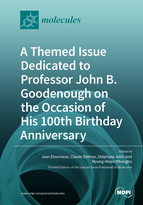A Themed Issue Dedicated to Professor John B. Goodenough on the Occasion of His 100th Birthday Anniversary
A special issue of Molecules (ISSN 1420-3049). This special issue belongs to the section "Inorganic Chemistry".
Deadline for manuscript submissions: closed (30 April 2021) | Viewed by 58075
Special Issue Editors
Interests: solid state chemistry (inorganic and organic-inorganic materials); optical materials (pigments, UV-absorbers, TCO, X-chromes, fluorescent and long lasting phosphorescent materials, p-type semiconductors, photovoltaics, etc.); structure-property relationship; impact of defects on properties
Special Issues, Collections and Topics in MDPI journals
Interests: layered oxides and hydroxides; positive electrodes for lithium and alkaline batteries
2. State Key Laboratory of Structural Chemistry, Fujian Institute of Research on the Structure of Matter (FJIRSM), Chinese Academy of Sciences (CAS), Fuzhou 350002, China
3. State key Laboratory of Crystal Materials, Shandong University, Jinan 250100, China
Interests: solid state chemistry; materials chemistry; condensed matter physics; magnetic properties; optical properties; superconductivity; electronic band structure calculations; structure-property correlations
Special Issues, Collections and Topics in MDPI journals
Interests: chemical and physical properties of borides; intermetallics; high Tc superconductors; relations structure properties; prediction of new materials by first-principle investigations
Special Issue Information
Dear colleagues,
This Special Issue of Molecules is dedicated to Professor John B. Goodenough (born July 25, 1922, Jena, Germany), American physicist, who won the 2019 Nobel Prize for Chemistry for his work on developing lithium-ion batteries.
Goodenough received a bachelor’s degree in mathematics from Yale University (1943) while serving in the United States Army Air Forces as a meteorologist. After the end of World War II, he did his graduate studies in physics at the University of Chicago, where he earned a master’s degree in 1951 and a doctorate in 1952.
Goodenough joined Lincoln Laboratory at the Massachusetts Institute of Technology as a research scientist in 1952. In 1976, he became a professor and the head of the Inorganic Chemistry Laboratory at the University of Oxford (England). In 1986, he became a professor of the Departments of Mechanical Engineering and Electrical and Computer Engineering at the University of Texas at Austin. He has been honoured with a National Medal of Science (2011), a Charles Stark Draper Prize (2014), a Copley Medal (2019), and a Nobel Prize (2019).
Goodenough has made two seminal contributions in the area of solid-state materials. One is on superexchange interactions of magnetic materials, and the other on lithium-ion batteries based on transition metal oxides. His contribution to our understanding of superexchange interactions took place while working at Lincoln Laboratory. The magnetic moments of two magnetic cations joined to a common, nonmagnetic anion can couple either antiferromagnetically or ferromagnetically. This superexchange phenomenon was first noticed by Hendrik Kramers in 1934, and its theoretical description was given by Phillip Anderson in 1950. In the late 1950s, John Goodenough examined the structural factors governing the sign and strength of superexchange to develop a set of semi-empirical rules for superexchange, and so did Junjiro Kanamori. Ever since, these semi-empirical rules have been known as Goodenough–Kanamori rules and have greatly influenced our thinking about magnetic materials.
Goodenough made his contribution to lithium batteries while working at the University of Oxford. The intercalation and deintercalation of an alkali metal in transition metal chalcogenides had been actively investigated in several countries: at Bell Labs in the United States, by J. Rouxel in France, and by B. Steele in England. At that time, the main purpose of the studies was to examine electronic properties. Stanley Whittingham was the first to publish in 1976 the electrochemical intercalation of lithium in titanium disulfide. Then, several groups focused their studies on the intercalation of lithium and sodium in other chalcogenides and in oxides. In 1980, Goodenough and his collaborators made the very first Li-LiCoO2 battery, which attracted much attention toward practical applications. This seminal work opened the door to numerous practical applications of lithium-ion batteries, which have become indispensable in our everyday life. He also showed that the cell voltage could be increased by using the inductive effect of polyanions. Goodenough proposed the currently used positive electrode material, LiFePO4, in 1997.
We plan to organize a Special Issue honoring John Goodenough’s distinguished scientific career over the past 70 years. This Special Issue will consist of communications, original research articles, and review articles related to magnetic properties and alkali ion batteries as well as anecdotes on John Goodenough.
Dr. Stephane Jobic
Prof. Dr. Claude Delmas
Prof. Dr. Myung-Hwan Whangbo
Prof. Dr. Jean Étourneau
Guest Editors
Manuscript Submission Information
Manuscripts should be submitted online at www.mdpi.com by registering and logging in to this website. Once you are registered, click here to go to the submission form. Manuscripts can be submitted until the deadline. All submissions that pass pre-check are peer-reviewed. Accepted papers will be published continuously in the journal (as soon as accepted) and will be listed together on the special issue website. Research articles, review articles as well as short communications are invited. For planned papers, a title and short abstract (about 100 words) can be sent to the Editorial Office for announcement on this website.
Submitted manuscripts should not have been published previously, nor be under consideration for publication elsewhere (except conference proceedings papers). All manuscripts are thoroughly refereed through a single-blind peer-review process. A guide for authors and other relevant information for submission of manuscripts is available on the Instructions for Authors page. Molecules is an international peer-reviewed open access semimonthly journal published by MDPI.
Please visit the Instructions for Authors page before submitting a manuscript. The Article Processing Charge (APC) for publication in this open access journal is 2700 CHF (Swiss Francs). Submitted papers should be well formatted and use good English. Authors may use MDPI's English editing service prior to publication or during author revisions.










